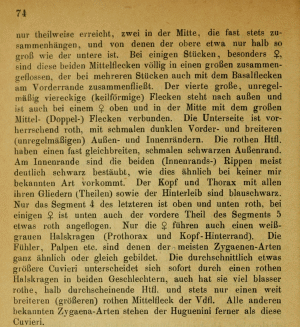

 +3Kontinente:AS
+3Kontinente:AS3. Biologie
3.1. Nahrung der Raupe
- [Apiaceae:] Eryngium macrocalyx
Hofmann & Tremewan (2020: 253) (dort viele weitere Details und Fotos zur Larvalbiologie) nennen Eryngium macrocalyx als einzige bekannte Freiland-Raupennahrungspflanze - in der Zucht werden aber auch andere Eryngium-Arten als Futter akzeptiert. Im Freiland waren die Raupen nur an den Blättern direkt unter dem Blütenstand zu finden: "According to C. M. Naumann (in litt.), pre-diapause larvae appeared to feed exclusively to the underside of the rosette leaves immediately below the flower; here their characteristic feeding marks could be observed, but none was observed on the much larger leaves of the first and second year plants of E. macrocalyx which lacked inflorescences."
4. Weitere Informationen
4.1. Taxonomie
Hofmann & Tremewan (2017, 2020) stellen Zygaena huguenini zusammen mit Z. centaureae und Z. laeta - in die Z. centaureae-group der Untergattung Mesembrynus.
4.2. Faunistik
Locus typicus ist Usgent [jetzt Ösgön] in Kirgisistan. Nach Hofmann & Tremewan (2020: 251) (dort weitere Details) ist die Art auf kleine Teile von Zentralasien beschränkt: "[...] where it is found in Kyrgyzstan, Uzbekistan and Tajikistan (only one recent record." Die Fundhöhen reichen dabei von 1.500-3.100 m, wobei die meisten Funde die Hochlagen betreffen.
(Autor: Erwin Rennwald)
4.3. Literatur
- Hofmann, A.F. & W.G. Tremewan (2017): The Natural History of Burnet Moths (Zygaena Fabricius, 1775) (Lepidoptera: Zygaenidae). Part 1. – 630 S.; Munich – Vilnius (Proceedings of the Museum Witt).
- Hofmann, A.F. & W.G. Tremewan (2020): The Natural History of Burnet Moths (Zygaena Fabricius, 1775) (Lepidoptera: Zygaenidae). Part III.1 u. III.2. - 1097 S.; Munich – Vilnius (Proceedings of the Museum Witt, 6 (3.1 + 3+2)).
- Erstbeschreibung: Staudinger, O. (1887): Centralasiatische Lepidopteren. — Entomologische Zeitung 48 (1-3): 49-102. Stettin (R. Grassmann).







